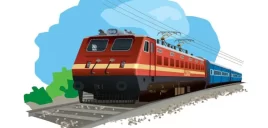IR passenger stock is mostly built with side buffers and screw couplers that have to be manually connected. The side buffers have single helical spring elements. The notable exceptions are the new [2/00] Alsthom LHB design coaches that have CBC (centre-buffer-coupler).
IR is now introducing tightlock CBC on passenger stock. This started as an experiment in the early 2000s. One rake of the Prayagraj Express was fitted with CBC as a trial. CBC overcome some of the limitations of the screw couplers — limited draft load and energy absorption capacity, lack of anti-climbing feature, etc. CBC would also reduce the inter-coach distance. [12/05] More trains, such as the Godavari Exp. and Charminar Exp. now have CBC rakes.
All new freight stock and container rake wagons for CONCOR, have CBC (MCB (or ‘Janney’ or ‘knuckle’ (US style) couplers). In particular newer freight stock has AAR type ‘E’ CBC usually with high-capacity draft gear. But there are still some older freight cars which have hook couplers with side buffers, as well as many with screw couplers.
Transition Couplers There are also ‘transition’ couplers, which have a CBC mechanism for coupling to other CBC, but which also have a central screw coupling provision allowing coupling to wagons which do not have CBC. There are two side buffers provided as well. These were useful when CBC were just being introduced and there was a lot of freight stock that had screw couplers, but they have now gradually lost their importance as more and more of the freight stock is fitted with CBC. These days only locos and brake vans tend to have transition couplers. Older BOX wagons, older diesels (many WDM-2’s) and other older rolling stock had Henricot Transition Couplers with a double screw arrangement. Somewhat newer rolling stock had the so-called Alliance or Clevis Transition Coupler. This had a clevis to be locked under the knuckle before using the screw coupling. A locking pin indicates whether the CBC portion is properly coupled or not.
Locomotives have transition couplers (see above) to allow them to hook up to either CBC or screw-coupled stock, and they also have side buffers. RDSO has recently [2004] come up with new design buffers for locos that have three times the energy storage capacity of the normal side buffers. These use packs of four rubber compression springs instead of the usual helical spring elements for energy storage.
Plate Couplers are temporary or short-run couplers that can be used to couple locomotives without CBC couplers to CBC-fitted wagons. Pocket Couplers, similarly, are used for temporarily coupling incompatible wagons. Both of these types of temporary couplers do not perform well in practice. They were also generally in short supply at marshalling yards and elsewhere. The move to block rakes of CBC wagons in the 1980s greatly reduced the demand for these temporary coupler types.
The Jones coupler (an adaptation of the Norwegian coupler) coupler is used on some MG and NG lines. Also known as the chopper coupler, this uses a hook (the chopper) which fits into a yoke on the coupler of the next car. A bar behind the yoke controls the tension in the coupler. MG wagons and coaches have a the chopper at one end and the non-chopper coupler at the other end, hence a rake of MG wagons has to have them all oriented in the same way.
MG locos have the choppers at both ends. When coupling a loco to a wagon, the loco’s chopper is used if coupling to the non-chopper end of the wagon, but the wagon’s chopper is used if coupling to the chopper end.
Jones couplers were developed in India and later spread to several east African and south-east Asian railways. Some NG lines still use a basic Norwegian (or ‘chopper’) coupling, which has a square or circular face with a slot coming down about half-way from the top.
Some NG lines use(d) the ABC Patent Coupling (ex-GIPR: Arvi-Pulgaon, Achalpulpur-Murtijapur-Yavatmal, Daund-Baramati, etc.). This has a disk that rotates and latches on to a horizontal loop from the mating coupler. The Darjeeling Himalayan Railway uses a rudder coupling system to deal with the severe curvature on some sections of its route. However, the Kishanganj branch of the DHR used chopper couplers, as can be seen on the DHR C class Pacific at Mumbai and the lone Garratt made for this line.
EMUs use Scharfberg couplers which are a centre-buffer type which automatically connect the electricity and air links as well. The coupler face is rectangular (from above) and has semicircular ends. A large pin projects from the end of the coupler, which mates with a corresponding hole in the coupler of the other car. DMUs also use these couplers with regular twin brake pipes, although in some cases (e.g. Jallandhar DMUs) they are modified to have different brake hoses than the integrated ones that are part of the couplers. In IR parlance, these couplers are called ‘Shaku’ couplers.
Screw Coupler Limitations
The screw couplers in use on passenger stock have some pretty restrictive limits on the tensile force they can handle. Below are the starting load limits specified for BG stock using screw couplers on different gradients:
| Gradient |
Rake weight |
| Level |
7000t+ |
| 1 in 500 |
5000t |
| 1 in 200 |
2800t |
| 1 in 150 |
2250t |
| 1 in 100 |
1700t |
With gradients of 1 in 60 or 1 in 50, the allowable load is as low as 1000t or less, which means that most Mail and Express trains running today, with 17-18 coaches or even longer rakes, need bankers for such gradients.
Buffers
The side buffers typically used on locomotives, coaches, and wagons mostly use helical springs for compression resistance. More recently, newer buffer designs have been brought into use that combine the use of helical springs with rubber or synthetic compression elements, including some buffer designs that rely entirely on multiple packs of rubber compression packs. Buffer capacity in the past was low, at about 450kgf-m and the standard loco buffer having a capacity of 490kgf-m. Higher capacity buffers of 1030 and 1225 kgf-m have been introduced and RDSO’s most recent design is for a buffer of capacity 1225kgf-m.
History of Couplers in India
Originally, Indian coupling consisted simply of chains — one in the middle and one on either side as back-ups — and buffers that were extensions of the side structural members of the coaches (“dumb” buffers) for freight cars. Passenger cars often had buffers filled with materials like horsehair.
Spring buffers were employed from about 1850, starting with under-wagon leaf spings, and evolving into the modern coil-spring buffers that contain the spring mechanism inside the buffer body.
Five-link and 3-link chain couplings survived into the 20th century, especially for low-speed (under 40km/h) operations. The linking chains evolved to have a screw mechanism (hence “screw coupler”) to keep buffers of adjacent cars touching and slightly in compression so as to provide a smoother transition on starting a train. By the 1920’s chain couplings almost all disappeared, especially as vacuum braking came into wide use.
The only steam class with automatic couplers were the WGx subclass used for heavy freights on SER.
In 1980, IR made the move to using block rakes of CBC wagons as far as possible for goods movement. This meant that the problems of coupler incompatibility among wagons and among locomotives and wagons at marshalling yards and elsewhere were greatly diminished.
Source – IFRCA.org
Disclaimer: The Information /News /Video provided in this Platform has been collected from different sources. We Believe that “Knowledge Is Power” and our aim is to create general awareness among people and make them powerful through easily accessible Information. NOTE: We do not take any responsibility of authenticity of Information/News/Videos.
This entry was posted in 2 Railway Employee, STUDY NEW, Railway Employee











